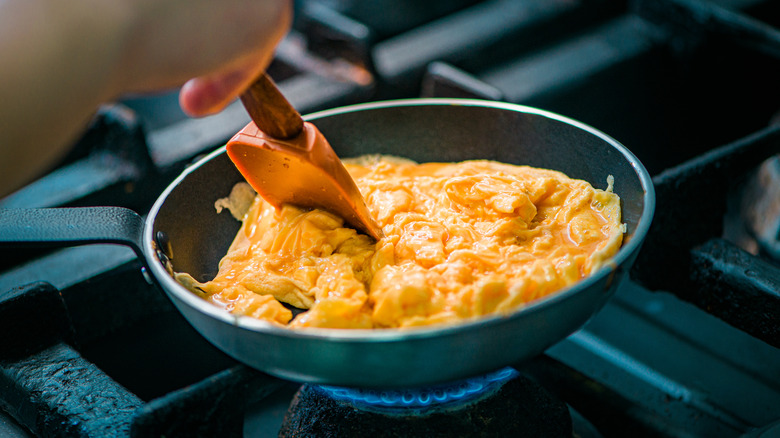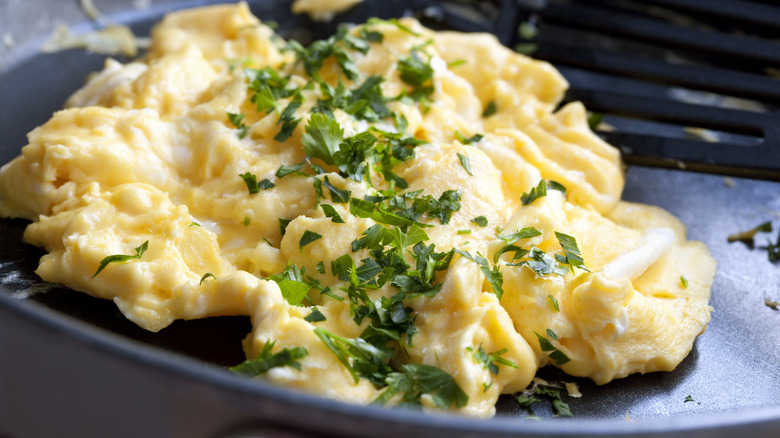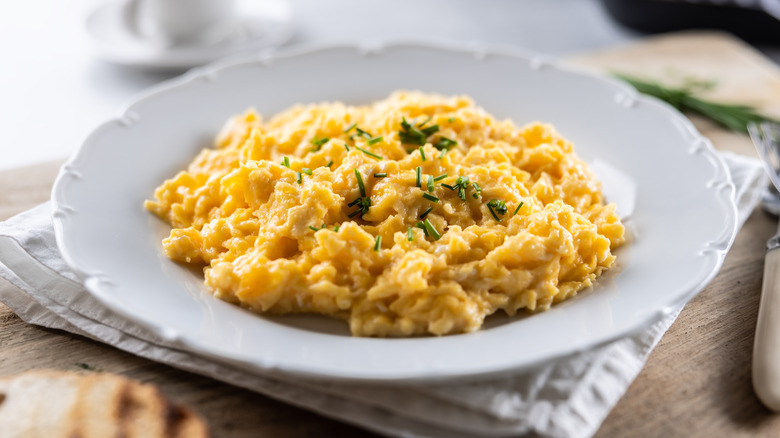The Best And Worst Type Of Pan To Make Scrambled Eggs In
Even the most experienced professional chefs acknowledge that scrambled eggs are notoriously hard to nail. While this dish might be one of the most universally loved breakfast staples worldwide, just one cooking mistake can transform it into a dry, rubbery mess. Fortunately, there are numerous tips on how to make restaurant-quality scrambled eggs at home, ranging from the best whisking techniques to the ideal time to remove them from the heat. However, if there's one piece of advice you should always remember, it's to use a nonstick pan for the task.
Eggs are infamous for sticking to the surfaces of skillets in the culinary world. Nonstick pans are specifically coated with a synthetic fluoropolymer that prevents food from sticking, making them excellent for scrambling eggs. You're still required to use a bit of butter or oil to prevent burning and sticking; beyond that, you don't really have to worry about this issue.
On the other hand, cast iron pans are typically the worst choice for making scrambled eggs. While their heat distribution surpasses that of nonstick pans, your food will undoubtedly stick to the surface of your skillet unless it has been meticulously lubricated. Sticking can reduce your scrambled egg yield, but at worst, you could end up with a seriously burnt pan that will require hours of soaking, scrubbing, and reseasoning to fix.
Keep the pan's heat down and stir continuously
Most professional cooks agree that low to medium heat is the best condition to keep scrambled eggs creamy. Eggs are primarily composed of water and are not dense, so when they are overcooked, their protein molecules begin to coagulate and expel all that moisture. Maintaining low burner heat prevents this process from happening too quickly, giving you more time to scramble without ending up with burnt or stuck-on pieces. You can still achieve delectably soft eggs under high heat, but you'll need to constantly move your pan on and off the burner to achieve the same results.
As you pour your egg mixture into the pan, keep things moving with a silicone spatula. Allowing your food to rest increases the chances that the eggs will crust up, and create a papery film at the bottom of the skillet. Constant stirring helps prevent this issue, and ensures that all sides of your scramble heat evenly. Moving the eggs around also gives you better control over the size of your curds. Large flips will keep the pieces of your scrambled eggs large, while rapid stirring will result in smaller grains.
Other tips for cooking delectably soft scrambled eggs
Adding liquids can truly turn scrambled eggs into a masterpiece, particularly if you're looking to experiment with the texture of your food. For instance, a splash of water can create airier curds reminiscent of a soufflé. If you're aiming for a creamier scramble, the fat in a dash of heavy cream or half-and-half can add smoothness to the dish; adding a bit of acid will keep your eggs soft. For those seeking a dairy-free option that still achieves similar results, a cornstarch slurry can be an excellent substitute. The starch helps prevent the egg's protein molecules from coagulating too tightly under heat, ensuring rich curds whether you're cooking over a low or medium flame.
Toppings are another fantastic way to enhance the flavors of scrambled eggs just before serving. Shredded cheddar melts beautifully when sprinkled over hot curds, resulting in cheesier, creamier eggs. While chives and green onions are common garnishes, adding crunchy bacon bits can introduce a savory texture contrast.



